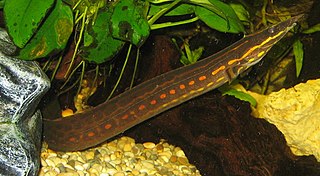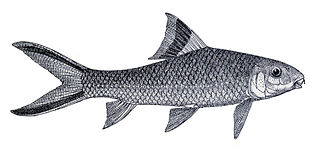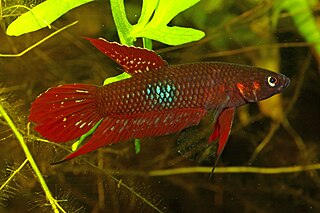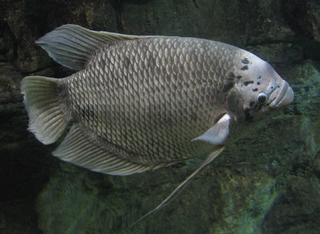
Sundadanio is a genus of freshwater ray-finned fishes and it is one of two genera in the family Sundadanionidae, known as the tiny danios. These fishes are typically found in peat swamps and blackwater streams, in Borneo and Sumatra in southeast Asia. At up to 2.3 cm (0.91 in) in standard length they are very small, but still larger than their close relatives Paedocypris. Species of the two genera are often found together.

Sundadanio axelrodi is a species of freshwater ray-finned fish belonging to the family Sundadanionidae, the tiny danios. This fish is known only from Bintan Island in the Riau Islands east of Sumatra. Originally described as a rasbora, Rasbora axelrodi, this tiny species was later deemed to be more closely related to the danios but not enough to be moved into the genus Danio. Sundadanio axelrodi reaches a maximum size of 1.7 cm. Sundadanio was considered monotypic until the genus was reassessed by Conway, Kottelat and Tan in 2011.

The fire eel is a relatively large species of spiny eel. This omnivorous freshwater fish is native to Southeast Asia but is also found in the aquarium trade. Although it has declined locally due to overfishing, it remains common overall.

The painted terrapin, painted batagur, or saw-jawed turtle is a species of turtles in the family Geoemydidae. It was formerly in its own genus, Callagur, but has been reclassified to the genus, Batagur.

The Malaysian giant turtle or Bornean river turtle is a species of turtle in the family Bataguridae. It is monotypic within the genus Orlitia. It is found in Indonesia and Malaysia.
The goldstripe rasbora is a species of ray-finned fish in the genus Rasbora. It is a benthopelagic freshwater fish found in Malaysia and Indonesia.
The yellow rasbora is a species of ray-finned fish in the genus Rasbora from Southeast Asia. It is a primarily freshwater fish originally from Java island in Indonesia. It is known as the Wader pari fish in the Indonesian language. In addition, it was a protein source for the local community during the old days.

The sucker barb is a species of freshwater ray-finned fish belonging to the family Cyprinidae, the carps, barbs, minnows and related fishes. It is the only species in the monospecific genus Barbichthys. This species is found in southeast Asia where it occurs in Laos, Cambodia, Thailand, Malaysia, Brunei and Indonesia, in Java, Sumatra and Kalimantan.

The beardless barb is a species of freshwater fish in the family Cyprinidae. It is widespread in Southeast Asia. It grows to 25 cm (9.8 in) total length.

Betta coccina is a species of betta native to Peninsular Malaysia and Sumatra, Indonesia. It grows to a length of 5.6 cm (2.2 in). It can be found in the aquarium trade. Betta coccina, commonly known as the wine red betta or red fighting fish, is a species of freshwater fish in the family Osphronemidae. It is endemic to the peat swamps of Indonesia and Malaysia, where it inhabits acidic, slow-moving waters. The species is known for its striking red coloration and relatively peaceful temperament compared to other Betta species.

Datnioides microlepis, also known as the Indonesian tiger perch, Indo datmoid, Indonesian tigerfish, or finescale tigerfish, is a species of freshwater ray-finned fish belonging to the family Lobotidae, the tripletails and tiger perches. This species is endemic to the islands of Sumatra and Kalimantan in Indonesia.

The giant gourami is a species of large gourami native to freshwater habitats in Southeast Asia. It has also been introduced elsewhere. The species is commercially important as a food fish and is also farmed. It can be found in the aquarium trade, as well. The species has been used for weed control on highly invasive aquatic plants like Salvinia molesta, as the giant gourami can be a voracious herbivore.
Crossocheilus obscurus is a species cyprinid fish. It occurs on Sumatra (Indonesia) and in Peninsular Malaysia. It lives in fast flowing steams with rocky substrate.
Sundadanio atomus is a species of freshwater ray-finned fish belonging to the family Sundadanionidae, the tiny danios. It is endemic to Singkep, off Sumatra (Indonesia). It lives in peat swamp forests.
Sundadanio gargula is a species of freshwater ray-finned fish belonging to the family Sundadanionidae, the tiny danios. It is endemic to Bangka Island, off Sumatra (Indonesia). It lives in coastal peat swamp forests.
Sundadanio goblinus is a species of freshwater ray-finned fish belonging to the family Sundadanionidae, the tiny danios. It is endemic to Sumatra (Indonesia). It lives in coastal peat swamp forests.
Sundadanio margarition is a species of freshwater ray-finned fish belonging to the family Sundadanionidae, the tiny danios. It is endemic to Sarawak, Malaysian Borneo, and known from the Rajang and Sarawak River drainages. It lives in coastal peat swamp forests.
Sundadanio retiarius is a species of freshwater ray-finned fish belonging to the family Sundadanionidae, the tiny danios. It is endemic to Kalimantan, Indonesian Borneo, and known from the Kotawaringin and Kahayan River drainages. It lives in peat swamps and blackwater streams.
Sundadanio rubellus is a species of freshwater ray-finned fish belonging to the family Sundadanionidae, the tiny danios. It is endemic to Kalimantan, Indonesian Borneo, and known from the southern Kapuas River delta. It lives in peat swamp forests.
Parachela hypophthalmus is a species of freshwater ray-finned fish belonging to the family Xenocyprididae, the East Asian minnows or sharpbellies. It inhabits Thailand, Malaysia and Indonesia, in Sumatra and Borneo and has a maximum length of 16.5 centimetres (6.5 in). It has been assessed as least concern by the IUCN, and is considered harmless to humans.









